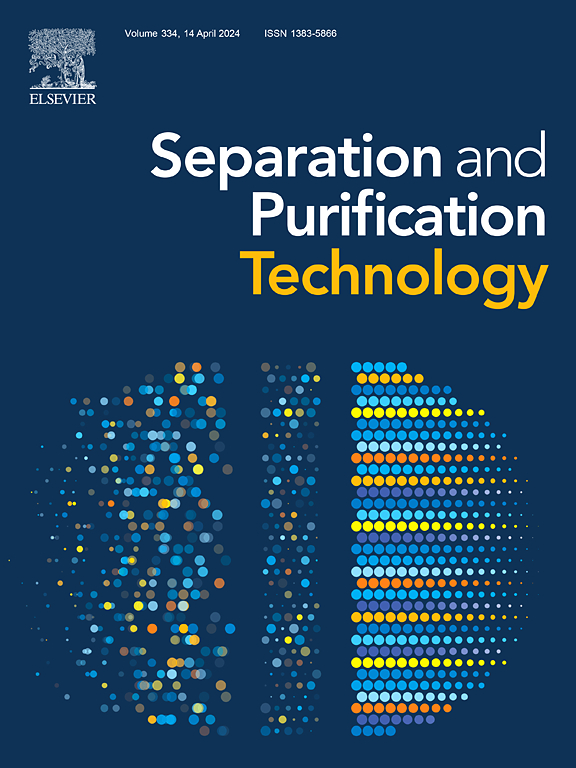Platinum oxide-based peracetic acid activation for efficient degradation of typical antibiotic
IF 8.1
1区 工程技术
Q1 ENGINEERING, CHEMICAL
引用次数: 0
Abstract
Peracetic acid (PAA)-based Advance Oxidation Process (AOP) is now used to treat pharmaceutically contaminated wastewater. Herein, PAA is heterogenically activated to degrade sulfamethoxazole (SMX) taking platinum oxide (PtO2) as a catalyst for the first time. PtO2/PAA system with good synergetic effect achieved 100 % SMX degradation in 75 min. Its corresponding kinetic rate constant (0.072 min−1) was exceptionally higher than six other Transition Metal/PAA-based systems tested as well as than PtO2 or PAA alone. The degradation improved by augmenting PAA and PtO2 inputs. Radical scavenging and electron paramagnetic resonance pointed acetylperoxy (CH3C(O)OO·) and acetoxyl (CH3C(O)O·) as the main reactive radicals attributing SMX abatement. X-ray photoelectron spectroscopy and diffraction along with electrochemical tests (cyclic voltammetric curve, electrochemical impedance spectra, and I-t curve) recommended that the electron transfer of Pt2+/Pt4+ also facilitated PAA activation. Density Functional Theory (DFT) assisted in predicting the reaction sites on SMX molecules. Four degradation pathways are proposed with the help of DFT calculations and eight intermediate products identified by High-Performance Liquid Chromatography Mass-Spactrometry. Dissolved organic matter, anions and different waterbodies had tolerable degradation inhibition. Efficient reactivity and adequate stability attest PtO2 as an ideal catalyst for oxidative degradations. The findings offer valuable insights into a novel, sustainable, and efficient approach to treat drug-contaminated wastewater.

基于氧化铂的过乙酸活化技术可高效降解典型抗生素
目前,基于过乙酸(PAA)的高级氧化工艺(AOP)已被用于处理受药物污染的废水。本文首次以氧化铂(PtO2)为催化剂,通过异源活化 PAA 来降解磺胺甲噁唑(SMX)。具有良好协同效应的 PtO2/PAA 系统在 75 分钟内实现了对 SMX 的 100% 降解。其相应的动力学速率常数(0.072 min-1)比其他六种测试过的基于过渡金属/PAA 的体系以及单独使用 PtO2 或 PAA 的体系都要高。通过增加 PAA 和 PtO2 的投入,降解效果有所改善。自由基清除和电子顺磁共振指出乙酰过氧(CH3C(O)OO-)和乙酰过氧(CH3C(O)O-)是导致 SMX 降解的主要活性自由基。X 射线光电子能谱和衍射以及电化学测试(循环伏安曲线、电化学阻抗谱和 I-t 曲线)表明,Pt2+/Pt4+ 的电子转移也促进了 PAA 的活化。密度泛函理论(DFT)有助于预测 SMX 分子上的反应位点。在 DFT 计算的帮助下,提出了四种降解途径,并通过高效液相色谱质谱法确定了八种中间产物。溶解的有机物、阴离子和不同的水体都对降解有一定的抑制作用。高效的反应性和足够的稳定性证明 PtO2 是一种理想的氧化降解催化剂。这些发现为采用新型、可持续和高效的方法处理药物污染废水提供了宝贵的见解。
本文章由计算机程序翻译,如有差异,请以英文原文为准。
求助全文
约1分钟内获得全文
求助全文
来源期刊

Separation and Purification Technology
工程技术-工程:化工
CiteScore
14.00
自引率
12.80%
发文量
2347
审稿时长
43 days
期刊介绍:
Separation and Purification Technology is a premier journal committed to sharing innovative methods for separation and purification in chemical and environmental engineering, encompassing both homogeneous solutions and heterogeneous mixtures. Our scope includes the separation and/or purification of liquids, vapors, and gases, as well as carbon capture and separation techniques. However, it's important to note that methods solely intended for analytical purposes are not within the scope of the journal. Additionally, disciplines such as soil science, polymer science, and metallurgy fall outside the purview of Separation and Purification Technology. Join us in advancing the field of separation and purification methods for sustainable solutions in chemical and environmental engineering.
 求助内容:
求助内容: 应助结果提醒方式:
应助结果提醒方式:


